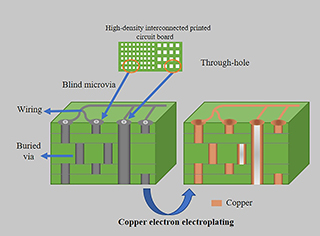

高密度互连印制电路板孔金属化研究和进展
收稿日期: 2020-11-30
修回日期: 2021-02-23
网络出版日期: 2021-03-02
基金资助
国家自然科学基金项目(21972118)
Studies and Progresses on Hole Metallization in High-Density Interconnected Printed Circuit Boards
Received date: 2020-11-30
Revised date: 2021-02-23
Online published: 2021-03-02
王赵云 , 金磊 , 杨家强 , 李威青 , 詹东平 , 杨防祖 , 孙世刚 . 高密度互连印制电路板孔金属化研究和进展[J]. 电化学, 2021 , 27(3) : 316 -331 . DOI: 10.13208/j.electrochem.201119
Printed circuit boards (PCBs) are almost the core components of all electronic systems. With the rapid development of sciences and technologies, PCBs are gradually developing in the direction of multi-layer, thin and high-density wiring due to the functionalization, miniaturization, lightweight and high reliability of electronic products, as well as the widespread popularization of the subminiature package such as chip scale package (CSP) and ball grid array (BGA). Therefore, High-density interconnected printed circuit boards (HDI-PCBs) arise. Hole metallization is one of the core technologies in HDI-PCBs and includes two processes composed of conductive treatment and electron electroplating. Electroless copper plating, as one of the conductive treatment methods, not only can deposit a copper layer with excellent conductivity and adhesion, but also has more reliable process maturity. However, reducing agent formaldehyde harms human health and environment. As a relatively eco-friendly and cheap reducing agent, hypophosphite is expected to replace formaldehyde in the process of the electroless copper plating if the copper deposition rate and the coating quality can be improved. Electron copper electroplating is closely related to the electrical properties of the electronic products. With the increase of PCBs integration, the diameters of holes decrease and the aspect ratios increase, which makes blind microvia and through hole more difficult to realize the superfilling and conformal thickening, respectively. For the superfilling of blind microvia, there are some mature models. But for the conformal thickening of through hole, there is no applicable theoretical guidance, and therefore, more studies are needed. It is very important to find suitable and novel additives besides the improvement of plating conditions for electron copper electroplating. In acidic sulfate copper electron electroplating process, although there are lots of studies on the additives, the interaction mechanism of the additives still needs to be further revealed, which not only contributes to understand the molecular mechanism of various additives, but also provides theoretical basis and guidance for the design and development of novel and efficient additives. In addition, the research and development of weakly alkaline and neutral electron copper electroplating process are also important for hole metallization of HDI-PCB. This paper firstly describes the concept of HDI-PCB, and then reviews recent studies and progresses on the electroless copper plating and acidic sulfate copper electron electroplating processes, which involves the effects of bath composition and operating conditions, the interactive mechanism of additives, and the filling and thickening mechanisms of the holes. Finally, the future directions towards basic research and novel electron electroplating development are highlighted.

/
| 〈 |
|
〉 |